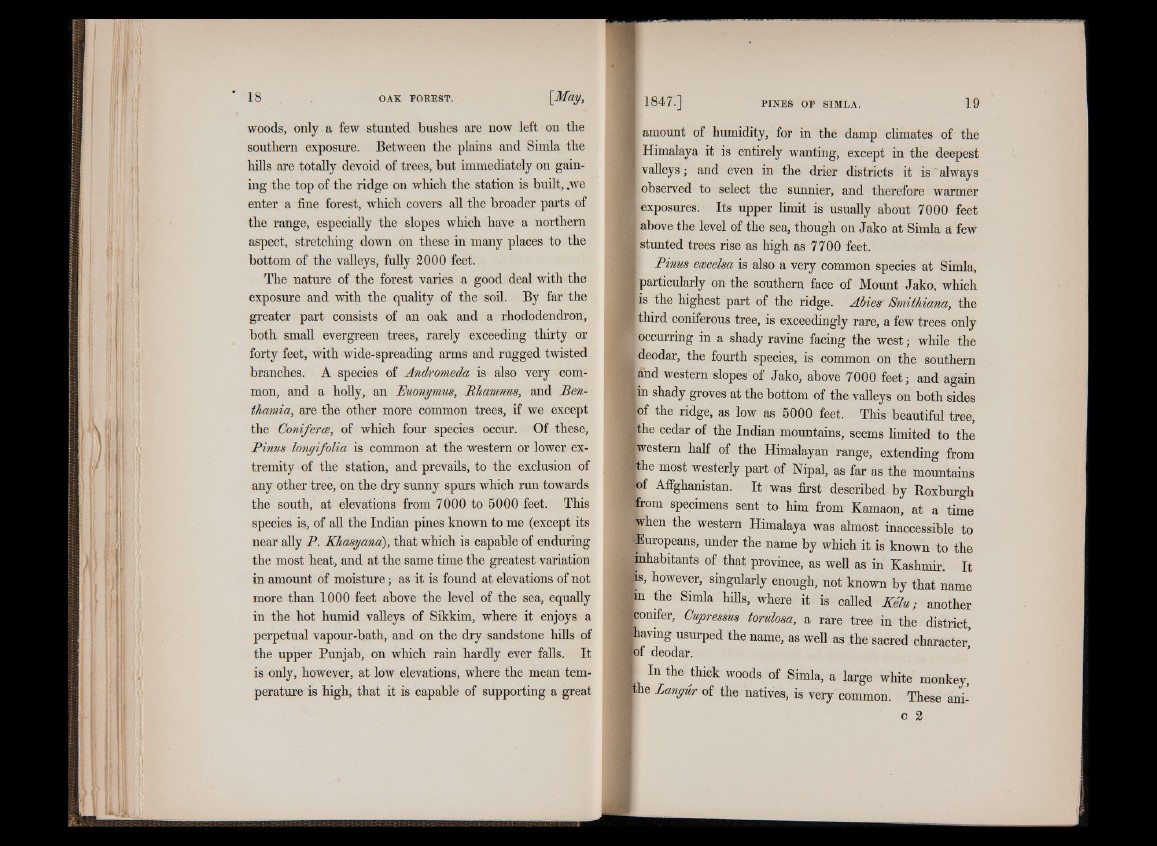
woods, only a few stunted bushes are now left on the
southern exposure. Between the plains and Simla the
hills are totally devoid of trees, but immediately on gaining
the top of the ridge on which the station is built, .we
enter a fine forest, which covers all the broader parts of
the range, especially the slopes which have a northern
aspect, stretching down on these in many places to the
bottom of the valleys, fully 2000 feet.
The nature of the forest varies a good deal with the
exposure and with the quality of the soil. By far the
greater part consists of an oak and a rhododendron,
both small evergreen trees, rarely exceeding thirty or
forty feet, with wide-spreading arms and rugged twisted
branches. A species of Andromeda is also very common,
and a holly, an JEuonymus, Phamnus, and Ben-
thamia, are the other more common trees, if we except
the Coniferce, of which four species occur. Of these,
Pinus longifolia is common at the western or lower extremity
of the station, and prevails, to the exclusion of
any other tree, on the dry sunny spurs which run towards
the south, at elevations from 7000 to 5000 feet. This
species is, of all the Indian pines known to me (except its
near ally P. Khasyana), that which is capable of enduring
the most heat, and at the same time the greatest variation
in amount of moisture; as it is found at elevations of not
more than 1000 feet above the level of the sea, equally
in the hot humid valleys of Sikkim, where it enjoys a
perpetual vapour-bath, and on the dry sandstone hills of
the upper Punjab, on which rain hardly ever falls. It
is only, however, at low elevations, where the mean temperature
is high, that it is capable of supporting a great
I amount of humidity, for in the damp climates of the
I Himalaya it is entirely wanting, except in the deepest
1 valleys; and even in the drier districts it is ~ always
I observed to select the sunnier, and therefore warmer
■ exposures. Its upper limit is usually about 7000 feet
I above the level of the sea, though on Jako at Simla a few
■ stunted trees rise as high as 7700 feet.
Pinus excelsa is also a very common species at Simla,
■particularly on the southern face of Mount Jako, which
■is the highest part of the ridge. Abies' Smithiana, the
■third coniferous tree, is exceedingly rare, a few trees only
■occurring in a shady ravine facing the west; while the
■deodar, the fourth species, is common on the southern
land western slopes of Jako, above 7000 feet; and again
■in shady groves at the bottom of the valleys on both sides
p)f the ridge, as low as 5000 feet. This beautiful tree,
■the cedar of the Indian mountains, seems limited to the
■western half of the Himalayan range, extending from
■the most westerly part of Nipal, as far as the mountains
¡of Afghanistan. It was first described by Roxburgh
gfrom specimens sent to him from Kamaon, at a time
when the western Himalaya was almost inaccessible to
Europeans, under the name by which it is known to the
■habitants of that province, as well as in Kashmir. It
|is, however, singularly enough, not known by that name
Rn the Simla hills, where it is called Kelu; another
fconifer, Cwpressus torulosa, a rare tree in the district
paving usurped the name, as well as the sacred character,’
[of deodar.
1 In the thick woods of Simla, a large white monkey,
I Lan9,u/r of the natives, is very common. These anic
2